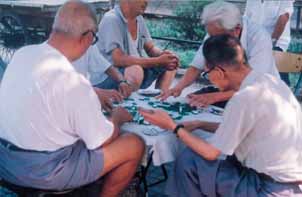Dear Atilla'r,
Hu Shi, a prominent
May Fourth Movement (1919) intellectual, once calculated that
four million man hours are spent playing mah-jongg in China
every day. "No people in the world spend more time
playing games than us Chinese," Hu observed.
Legend has it that
mah-jongg was first played in China during the lifetime
of Confucius, in
the Spring and Autumn period (770-476 BC) . Like all good
urban legends, this
one begins with a beautiful maiden who lived in seclusion in
her family's palace. She was bored spending every day alone,
so she invented a
game using domino-shaped pieces of ivory and bamboo and
invited three of her maids to play her new game. Each person
received 34 tiles which they would use to create a wall. The
exact rules the foursome
used are unknown,
but since that time "building the Great Wall," as
mah-jongg is
sometimes called, has been one of China's favorite ways to
idle away leisure
hours.
Mah-jongg was
banned frequently by emperors in the intervening years, but
the last attempt to
suppress the game ended in the year 500, during the
reign of Emperor He
Di.
The game became
popular all over China in the ensuing years. The rules were
often different from the way it is played today, and until the
late Qing
Dynasty (1644-1911)
the game was called maque (lit. 'sparrow') and madiao.
The name majiang
came into common use during the Qing Dynasty, and the rules
developed into what they are today, although even now majiang
is
played slightly
differently from family to family and city to city.
The next great
propagation of the game occurred in 1920 when an American
businessman named
Joseph P. Babcock realized that many expatriate residents of
Shanghai were playing as much mah-jongg as the Chinese. He
began exporting Chinese mah-jongg sets to the United States.
He copyrighted the name 'mah-jongg,' and issued a simplified
set of rules with each mah-jongg set sold. Babcock also gave
English translations to the tiles to ensure ease of use by
Americans.
By 1923, registered
sales of mah-jongg sets to the United States stood at
more than US$1.5
million. Mah-jongg sets were the sixth biggest export item
from Shanghai, after silk, lace, leather, eggs and tea. In one
of the
strangest twists to
the U.S. mah-jongg craze, the Department of Commerce
reported that large
quantities of bone were being exported from Kansas City
and Chicago to
China in order to turn out more mah-jongg sets.
Though by the end
of the 1920s the mah-jongg craze in the U.S. had faded,
the Great
Depression and the unemployment it generated again stimulated
an appetite for games. At some point in the next few decades,
Jewish women discovered their innate Chinese essence, and
started to play the game with as much as enthusiasm as a bunch
of Hong Kong tai-tais.
Though a detailed
description of the complex rules of mah-jongg would require
more space than this column affords, a brief description of
suits may help you to understand how the game works.
A mah-jongg set
consists 144 tiles. Like poker cards, the tiles are divided
into different
suits, namely:
* Ten Thousand
(wan) suit, which has the Chinese character for 10,000
and the characters
for one through nine.
* Circle (bing or
tong) suit, which also consists of numbers one though nine.
* Bamboo or Stick (tiao)
suit, which also consists of stylized sticks of values one to
nine. The tile for one stick, however, has a picture of a bird
(yaoji), said to be the mythical "bird of 100
intelligences."
* Wind (feng) suit,
consists of four different tiles with the Chinese characters
for north, south, east and west.
* Prime suit
consists of tiles with a red character meaning middle or China
(zhong), a green character for getting rich (fa), and a tile
with a blank rectangle, called a white board (bai ban).
* Flower (hui'r)
suit consists of two series, each numbered one to four.
The aim of the
game, like rummy, is to be the first to complete a hand. A
completed hand
consists of four sets of three (or four) tiles in a suit plus
an identical pair of any suit. The individual sets can be
triplets or quadruplets (identical) or sequenced.
At the beginning of
play, each of the four players sits at each side of a
square table, which
should be aligned with the cardinal compass points. All
the tiles are
placed face down on the table and are shuffled around. This is
called "washing the tiles" (xi pai). Each player
chooses 36 tiles, and arranges them in 2 rows of 18, one row
stacked on top of the other. The stacks are then pushed to the
middle of the table to form a square. Dice are rolled to
determine who starts taking tiles from the wall, and then the
game proceeds in a manner resembling rummy. One of the biggest
obstacles for beginners is that mah-jongg is often played very
rapidly, giving the novice very little time to think about
what tiles to take or discard.
Scoring is
complicated and rules vary widely from place to place, so even
once you have
learned the basics, you should not rush into an all-night
gambling session
with Hong Kong gangsters because you might find that they play
by different rules.



